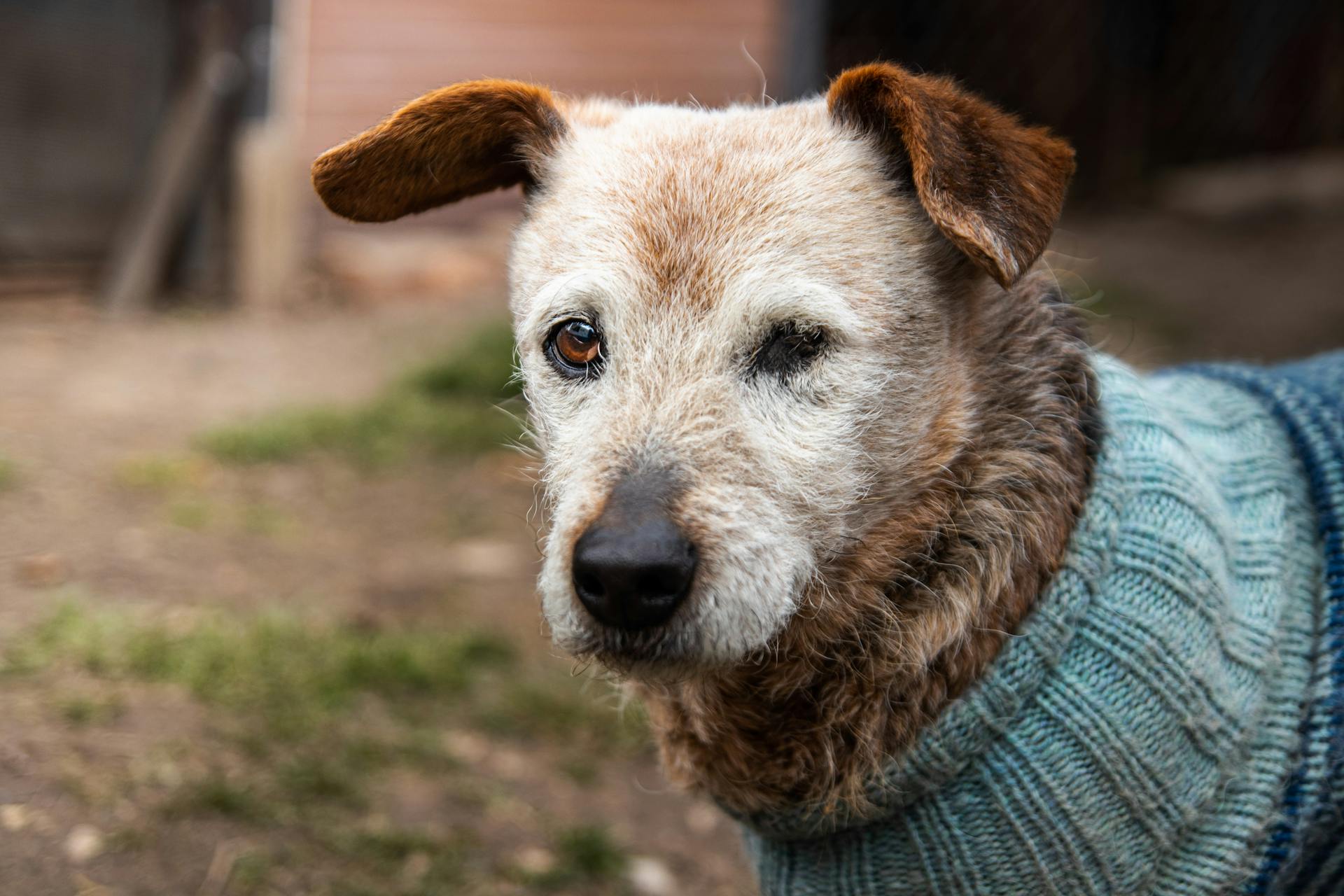
The Dog Aging Project is a groundbreaking initiative that aims to extend the lives of our beloved canine friends. Funded by the National Institutes of Health, the project was launched in 2016 with the goal of identifying the biological mechanisms that control aging in dogs.
Led by Dr. Matt Kaeberlein, a renowned aging researcher, the project involves a comprehensive study of over 10,000 dogs across the United States. These dogs will be followed for their entire lives, providing valuable insights into the aging process.
By studying the genetic and environmental factors that influence aging, the Dog Aging Project hopes to identify new treatments and interventions that can help dogs live longer, healthier lives. This could potentially lead to breakthroughs in human aging research as well.
Related reading: Aging Spots on Dogs
The Study
The Dog Aging Project is a collaborative research effort that aims to understand the factors that contribute to healthy aging in dogs. This project is led by Matt Kaeberlein, Ph.D., and involves over 40 experts from various fields and institutions.
Related reading: Anti Aging Drug Dogs
The primary purpose of the project is to determine whether rapamycin, a drug that affects both the immune system and metabolism, increases the lifespan of companion dogs. Rapamycin has been shown to increase the lifespan of mice.
The project is also investigating various measures of health in aging dogs, including age-related mobility, cardiology, and canine cognition. The research team is using data collected from DAP participants to investigate these areas.
The project includes a clinical drug trial of rapamycin, which is being conducted through the TRIAD clinical trial. The trial aims to determine whether rapamycin increases the lifespan of companion dogs and improves various measures of health in aging dogs.
The Dog Aging Project is also conducting a longitudinal study, where individual animals will be followed throughout life to understand the biological and environmental factors that determine why some dogs die early or succumb to diseases. The study will assess several age-related parameters, including cognitive function, heart function, and activity.
The project's research team is using a cloud-based computing platform, Terra, to store and analyze data collected from DAP participants. This platform allows researchers worldwide to access and contribute to the project's data.
The Dog Aging Project's research areas include:
- Genetics
- Microbiology
- Toxicology
- Canine cognition
- Age-related mobility
- Cardiology
- A clinical drug trial of rapamycin
The Project
The Dog Aging Project was initiated with the National Institutes of Health (NIH) in 2018. It's a pioneering effort that engages nearly 50,000 Americans in research. The project aims to understand aging in dogs and ultimately help us extend healthy lifespan of both humans and pets.
The project has created the largest longitudinal study of aging in the world, with substantial achievements including publishing over 50 influential peer-reviewed papers. This is a remarkable feat, especially considering the challenges posed by the COVID-19 pandemic. The project has also developed a free, open-access database with more than 36.5 million data points.
The project's efforts have sparked global research and inspired biotechnology companies to seek new life-extending treatments.
Worth a look: 50 Breeds of Dogs
Support the Continuation
The Dog Aging Project has made incredible strides in understanding aging biology and driving advancements in health. With its largest longitudinal study of aging in the world, it's no wonder why this project has gained so much attention.

This study, initiated with the National Institutes of Health (NIH) in 2018, has published over 50 influential peer-reviewed papers. That's a staggering amount of research in just a few years!
The project's free, open-access database contains more than 36.5 million data points, making it a valuable resource for scientists and researchers worldwide. Imagine the potential discoveries that can be made with such a vast amount of data!
The Dog Aging Project has also initiated the first-ever randomized clinical trial for longevity. This is a huge breakthrough in the field of aging research, and it's a testament to the project's commitment to finding new ways to extend healthy lifespan.
Here are some key facts about the Dog Aging Project's achievements:
- Created the largest longitudinal study of aging in the world
- Published over 50 influential peer-reviewed papers
- Developed a free, open-access database with more than 36.5 million data points
- Initiated the first-ever randomized clinical trial for longevity
The Dog Aging Project's success is a shining example of what can be achieved when scientists, researchers, and the public work together. Its loss would be a significant setback for the scientific community and the public's engagement with science.
Joining the Pack

To join the Dog Aging Project, you'll need to nominate your dog at the project website, DogAgingProject.org. This is the first step in becoming a member of the Dog Aging Project Pack.
Once you've nominated your dog, you'll be invited to set up a personal research portal where you'll answer scientific surveys about your dog and upload their veterinary records. This will help the research team get a better understanding of your dog's health and life experience.
As a member of the Dog Aging Project Pack, you'll be asked to complete an annual health survey about your dog, which will take around 2-3 hours to complete. You'll also be asked to fill out shorter surveys throughout the year, which should only take around 10-30 minutes each.
If your dog is eligible, they may also be invited to participate in additional research activities, such as genetic analyses or the collection of biological samples. These activities are all voluntary and can help advance our understanding of healthy aging in dogs.
For more insights, see: Could Shiba Inu Hit $1

Here's a summary of the requirements to join the Dog Aging Project Pack:
- Nominate your dog at DogAgingProject.org
- Set up a personal research portal and answer surveys about your dog
- Upload your dog's veterinary records
- Complete annual and shorter surveys about your dog's health
By joining the Dog Aging Project Pack, you'll be contributing to a groundbreaking study that aims to extend quality of life into advanced age for dogs and their humans.
Treatment Methods
To participate in the TRIAD study, you'll need to nominate your dog for the Dog Aging Project and complete a comprehensive survey about your dog.
First, you'll need to provide your dog's medical records for review.
A DNA sample will be collected from your dog's mouth using a swab provided by the study.
You'll also need to travel with your dog to the WSU VTH in Pullman, WA for a screening appointment.
At the screening appointment, your dog will receive a physical exam, including blood pressure measurements.
Blood, hair, urine, and fecal samples will be collected, and an electrocardiogram (ECG) and heart ultrasound (echocardiogram) will be performed.
For another approach, see: Why Dogs Wag Tail

If your dog passes the screening exam, they'll be randomly assigned to receive either rapamycin or a placebo for one year.
Enrolled dogs will need to return to the WSU VTH every six months for a three-year period.
At each return visit, a physical exam, blood pressure, sample collection, ECG, and echocardiogram will be repeated.
You might like: When Will Shiba Inu Reach 1 Cent
Frequently Asked Questions
Is the Dog Aging Project legitimate?
The Dog Aging Project is a legitimate community science project that relies on dog owners and veterinarians to fuel its research. It's a collaborative effort that values the input of its participants to advance our understanding of canine aging.
What drug is used in the Dog Aging Project?
The Dog Aging Project uses rapamycin, a medication, in its research. This study aims to explore rapamycin's effect on healthy aging in dogs.
How many dogs are in the Dog Aging Project?
The Dog Aging Project involves over 21,000 dogs. This large dataset helps researchers understand how a dog's environment affects their health.
Sources
- https://actionnetwork.org/petitions/support-the-continuation-of-the-dog-aging-project
- https://newsroom.uw.edu/news-releases/dog-aging-project-seeks-more-canine-participants
- https://www.afar.org/events/dog-aging-project-webinar
- https://hospital.vetmed.wsu.edu/2022/03/27/dog-aging-project-triad-study/
- https://cvmbs.source.colostate.edu/calling-all-canines-volunteers-needed-for-the-dog-aging-project/
Featured Images: pexels.com


